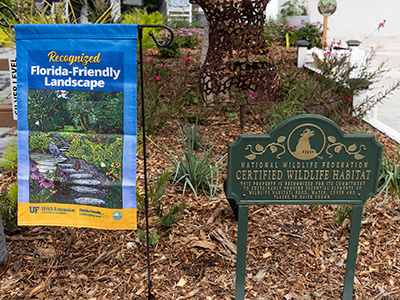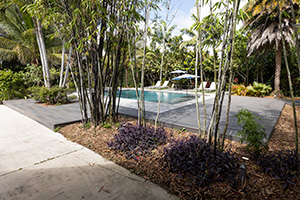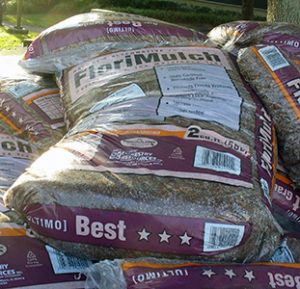Choosing and Installing Mulches

Mulch is used to cover the soil in a landscape or garden. It is often composed of tree bark, leaves, needles, wood or grass. Sometimes mulch is made from stone and other inorganic materials, such as recycled tires.
Mulch helps conserve water, control erosion, suppress weeds and of course provide aesthetic appeal; there are so many reasons to add mulch to your landscape!
Why should you use mulch?
Proper mulching is an essential component of any Florida-Friendly landscape. Perhaps most importantly, it is the cornerstone of a great weed-control program. Mulch keeps the soil moist longer after irrigation, too. This gives plant roots extra time to soak up water. Mulch also protects plant roots from extreme temperatures by creating a buffer between the soil and the air.
And mulch isn’t just good for your plants; it’s good for your soil. Organic mulches can add nutrients to the soil as they decompose. This improves your soil’s aeration, structure and drainage, as well as its ability to hold nutrients. Mulch can even help reduce erosion and protect plants from certain diseases.
In areas of deep shade, turfgrass and ornamental plants won’t thrive. And some areas are too difficult to mow or irrigate to sustain healthy turf. Consider using a Florida-Friendly organic mulch as an attractive alternative to bare ground in these shady and problematic areas.
Which mulch is right for your landscape?

Below is a list of different types of available mulch and their benefits and drawbacks.
Organic Mulches
Organic mulches are made from materials that were once living. The Florida-Friendly Landscaping™ program recommends organic mulches for herbs, vegetables, shrubs, fruit trees and other trees. They benefit the soil, suppress weeds and moderate temperature below the surface. Many studies have demonstrated that organic mulches improve the health and survivability of trees, shrubs and other plants. Organic mulches will break down, which means they will need to be replenished over time.
Pine bark is a byproduct of the forest industry. It comes in ground-up pieces and nugget forms and has a rich brown color. Pine bark settles slowly. One study by UF/IFAS found it to maintain two-thirds of its original depth after two years.

Pine straw (needles) comes from managed pine forests, which produce paper and wood products. They give a very natural look to landscapes. And, unlike some mulches, pine straw is not likely to wash away because the needles knit together. Pine straw is among the least expensive mulches, but it breaks down and settles quickly. You will have to re-mulch the area often.
Fallen leaves (including grass clippings) can be raked up for free in your landscape and used as mulch. This type of mulch is high in nutrients but decomposes quickly. You’ll need to rake regularly to keep your beds covered. Like pine straw, leaf mulch brings a very natural look to the landscape. Large leaves, like sycamore, may require shredding or mowing to prevent the mulch layer from matting.
Cypress mulch is composed of both wood and bark. Cypress trees grow in Florida’s forested wetlands. They are often harvested for lumber and used in fencing, flooring, furniture and other products. Leftover pieces are made into mulch, and sometimes entire trees are used for mulch. Because it may be sourced from endangered wetlands, the Florida-Friendly Landscaping™ program does not recommend the use of cypress mulch.
Mixed hardwood mulch is produced from scrap lumber, recycled pallets or tree stems too small for use in manufacturing. They settle faster than pine bark but significantly slower than pine straw or fallen leaves. Hardwood mulches are often dyed using organic colorants to add red, brown, black or gray color to your landscape. A word of caution: mixed hardwood mulch can be contaminated with chromated copper arsenate (CCA) from pressure-treated lumber. Since this substance is toxic to animals and humans, do not use around edible gardens and wear gloves when spreading on the landscape. To purchase mulch free of toxic substances like CCA, look for the Mulch and Soil Council (MSC) certification logo.
Melaleuca mulch is made from this invasive tree species. It gives the same traditional look as mixed hardwood and cypress mulches. The product is cured at a high temperature to kill any seeds so they won’t germinate in your garden. It settles very slowly, meaning it will last a long time. In one study by UF/IFAS, melaleuca mulch outperformed pine bark and cypress mulch in durability.
Eucalyptus mulch typically comes from farms in South and Central Florida. Trees there are grown specifically to be made into mulch. They grow quickly, so this mulch is considered renewable. Eucalyptus mulch is slightly less durable than cypress, but longer-lasting than utility mulch or pine straw.
Utility mulch is sold or given away for free by many utility companies. This mulch comes from the material gathered when trimming trees and plants growing too close to power lines. Be aware that it can come with weed seeds; sometimes dirt and leaf matter comes mixed in, too. For these reasons, utility mulch may not be a good choice for flower and vegetable gardens. It is, however, ideal for driveways, walkways and natural areas.
Inorganic Mulches
Inorganic mulches like rocks, gravel, shells or rubber, are very durable. They will last a long time and don’t break down like organic mulches. That said, they are not recommended for use as mulch in garden beds by UF/IFAS.

Gravel, rocks and crushed shells won’t contribute to the soil’s nutrient content or water-holding capacity. They also do not prevent weeds or create balanced soil temperatures like organic mulches. They can even become a nuisance if they get displaced onto lawns. While not recommended around plants, rock mulch may be used on pathways, in dry creek beds or under downspouts. Just be sure to put a landscape fabric down before adding the mulch or it will sink into our sandy soils.
Rubber mulches are generally less effective than organic mulches in suppressing weeds. This recycled material also absorbs heat, leading to extremely high temperatures in the ground beneath. Finally, some rubber mulch is harmful to the environment because it floats and can get washed away, where it leaches chemicals into local waterways.
How much mulch should you buy?
Florida-Friendly Landscaping™ recommends mulching to a depth of 3 inches. When mulching seedlings or small vegetables or herbs, only mulch to a 1-inch depth so that growth is not inhibited.
One cubic yard of mulch will cover 324 square feet of ground at 1 inch deep, or 108 square feet at 3 inches deep. At a 3-inch depth, one cubic yard of mulch will cover an area about 10 feet wide and long.
To find out how much mulch you need to cover a larger space, you’ll need to calculate the square footage of the area.
Rectangular areas: Multiply the length (L) of the planting bed by the width (W). Example: 5 feet long X 10 feet wide = 50 square feet to cover.
Circular areas: Measure the distance from the center of the circle to its edge. This is the radius of the circle. Multiply the radius by the radius again, then multiply the answer by 3.14. Example: 5 feet from the center to the edge X 5 feet from the center to the edge X 3.14 = 78.5 square feet to cover.
Irregular areas: Estimate these areas by dividing them into circles and rectangles. Add the smaller areas together to estimate the whole.
Once you have your square footage, multiply it by the desired depth of the mulch. Finally, divide that answer by 324 (the amount of mulch needed to cover one cubic yard). This answer will tell you how many cubic yards of mulch you need to cover your area. Example: (128.5 square feet to cover X 3 inches deep) divided by 324 = 1.2 cubic yards of mulch needed to cover.
How do you install mulch?
When applying mulch in the home landscape, follow these simple guidelines:
As mentioned previously, maintain a 2- to 3-inch layer around established trees, shrubs, and bedding plants and a 1-inch layer around seedlings or small vegetables and herbs. Don’t apply more than 3 inches, for excessive mulch can divert rain and irrigation meant for plants root systems.
Organic mulches decompose over time. As they do, they settle, reducing the depth of your mulch layer. When the depth falls below two inches, it’s time to replenish the mulch. You can do this easily by adding another thin layer of mulch on top of the existing bed. Replacing the mulch entirely isn’t recommended; you may damage surface-level plant roots. Some mulches can become matted, preventing water and air from seeping through. To combat this, lightly rake older mulch to refresh its appearance and benefit plantings.

Avoid “volcano mulching.” When mulch is piled against the base of a tree, it holds moisture. This encourages rot in the trunk. Mulch piled against the trunks of young trees may also create a habitat for rodents. These animals chew the tender bark, and can ultimately kill the trees. For these reasons, it is best to leave the base of plants bare. For large plants and trees, place the mulch about 1 foot from the base. For smaller plants, leave a couple of inches free of mulch around the base.
Mulch to the drip line or beyond. The mulched area around the tree should be at least 8 feet in diameter. In the forest a tree’s entire root system, which usually extends well beyond the drip line, would naturally be mulched by fallen leaves.
It is also recommended to avoid mulching along a curb, sidewalk or water’s edge because organic mulches can release nutrients that wash away into storm drains and waterways. Instead, use a groundcover or grass.
Mulching is a Florida-Friendly gardening technique that can reduce cost and labor in the garden; it increases the efficiency of irrigation, disease control and weed management. Mulching is also pleasing on the eye and makes for a unifying element in the landscape. For questions on mulch, contact your county Extension office.

